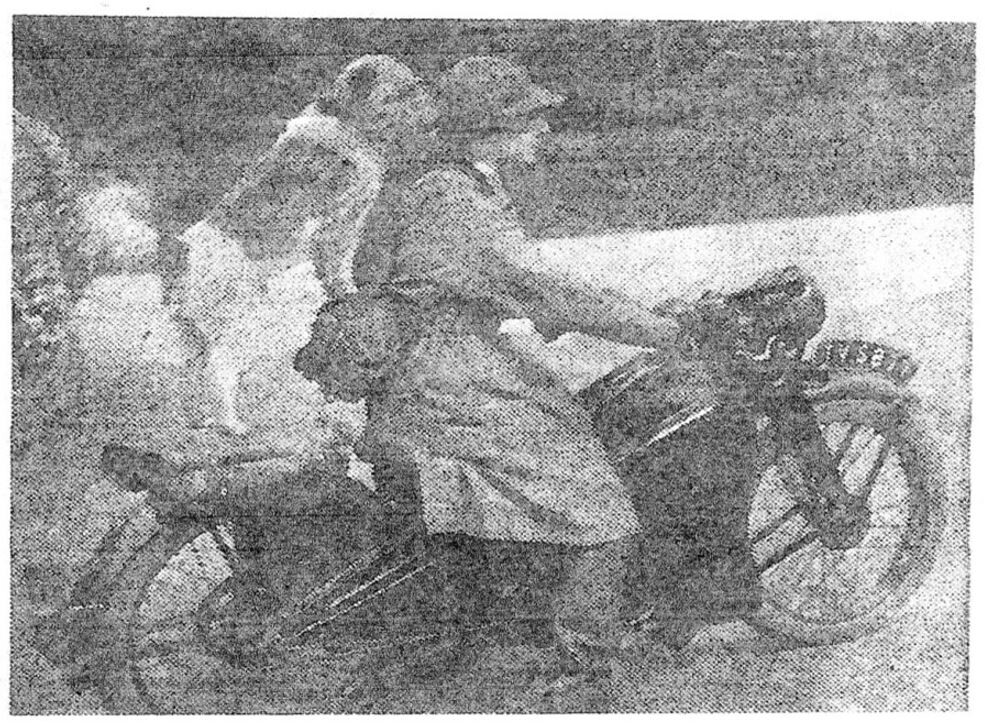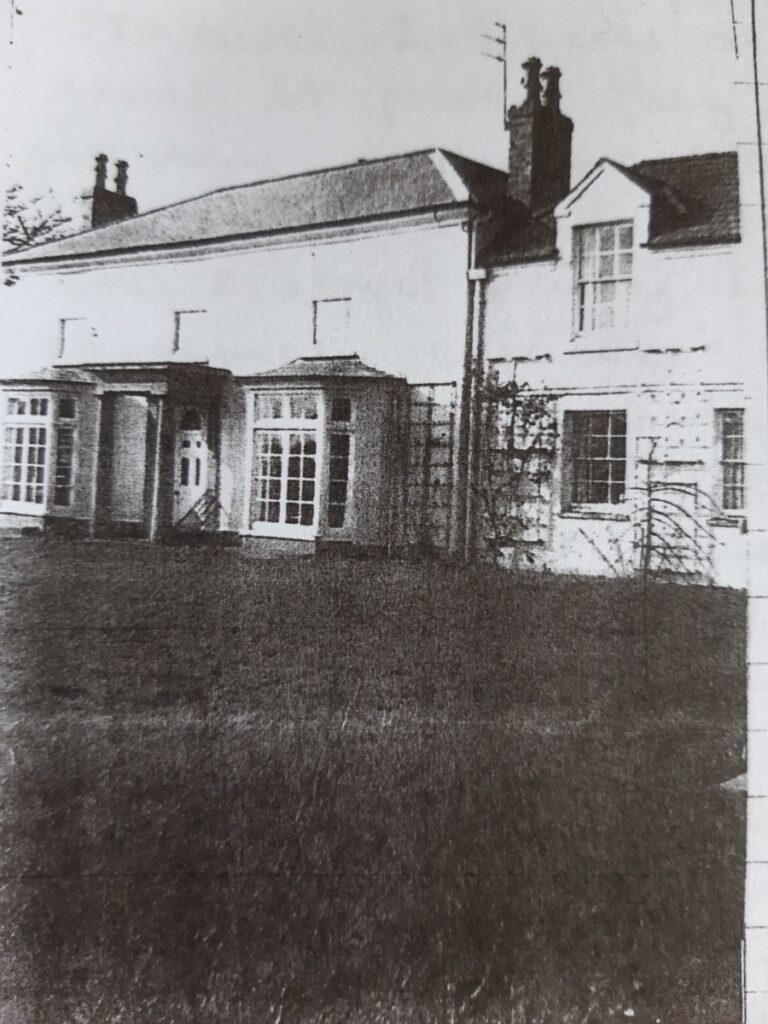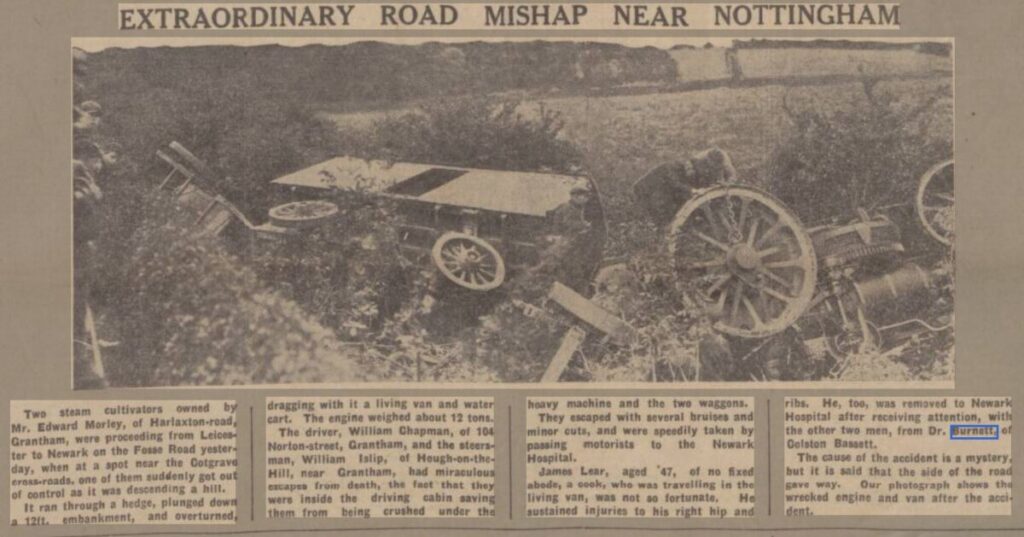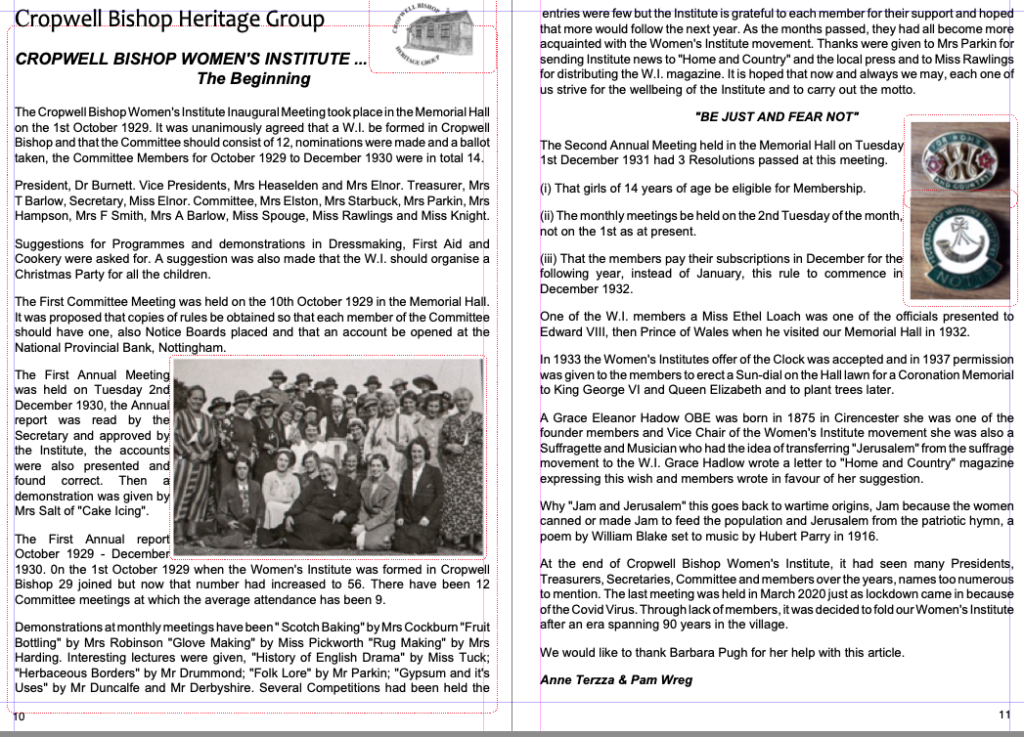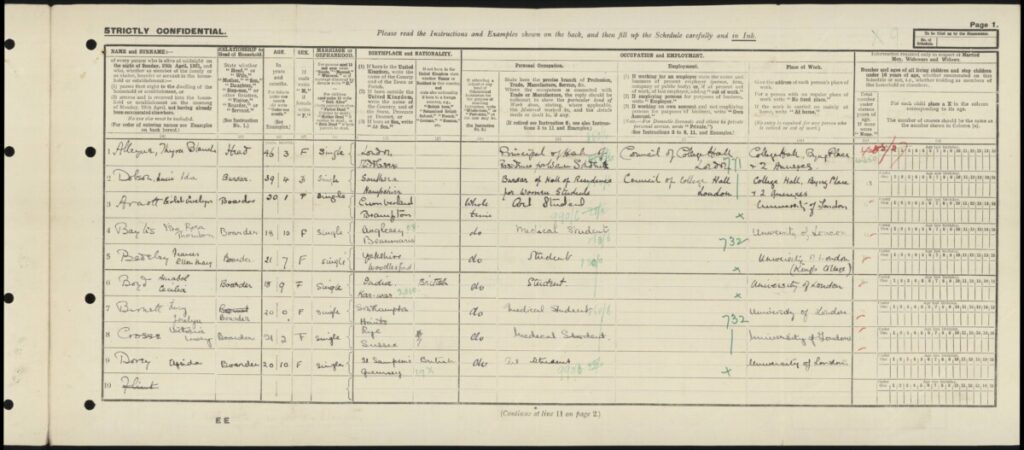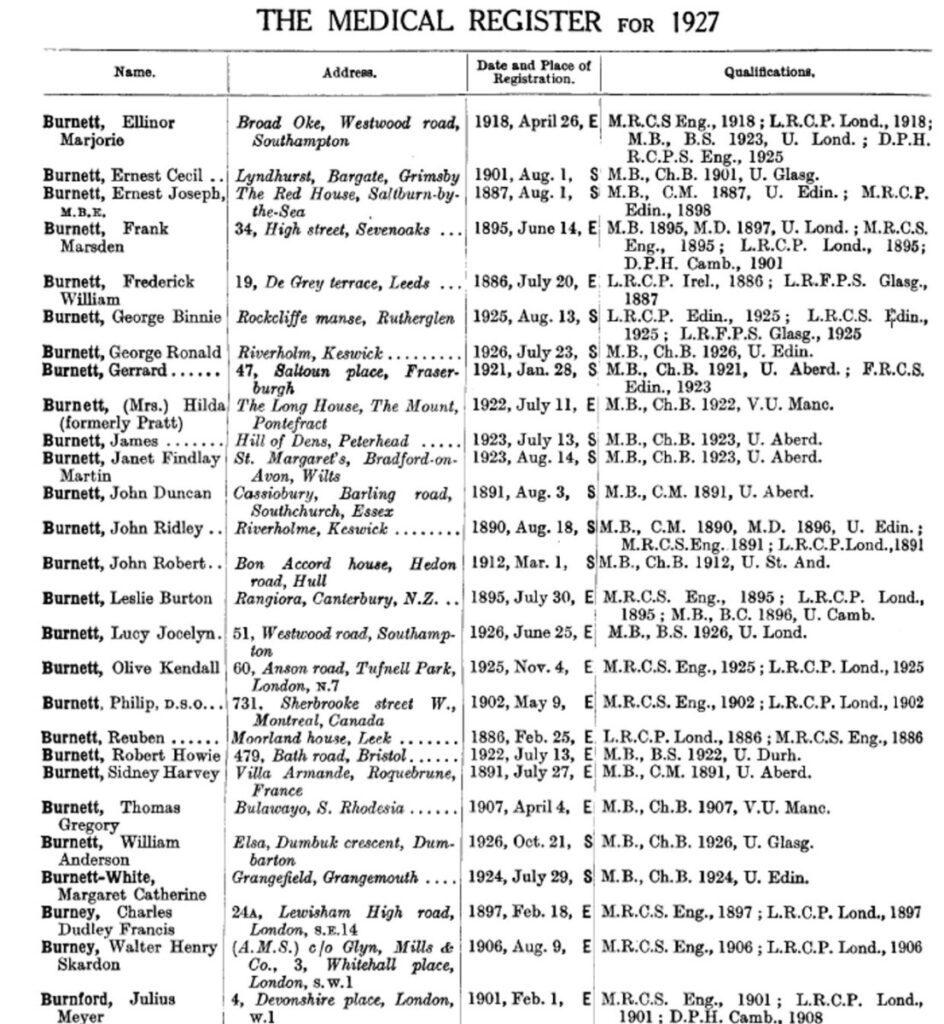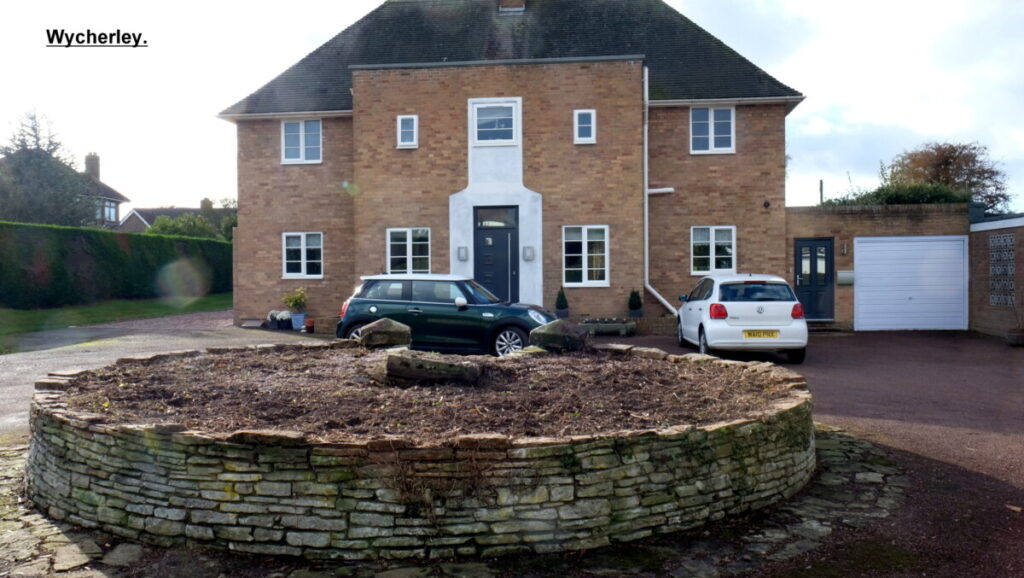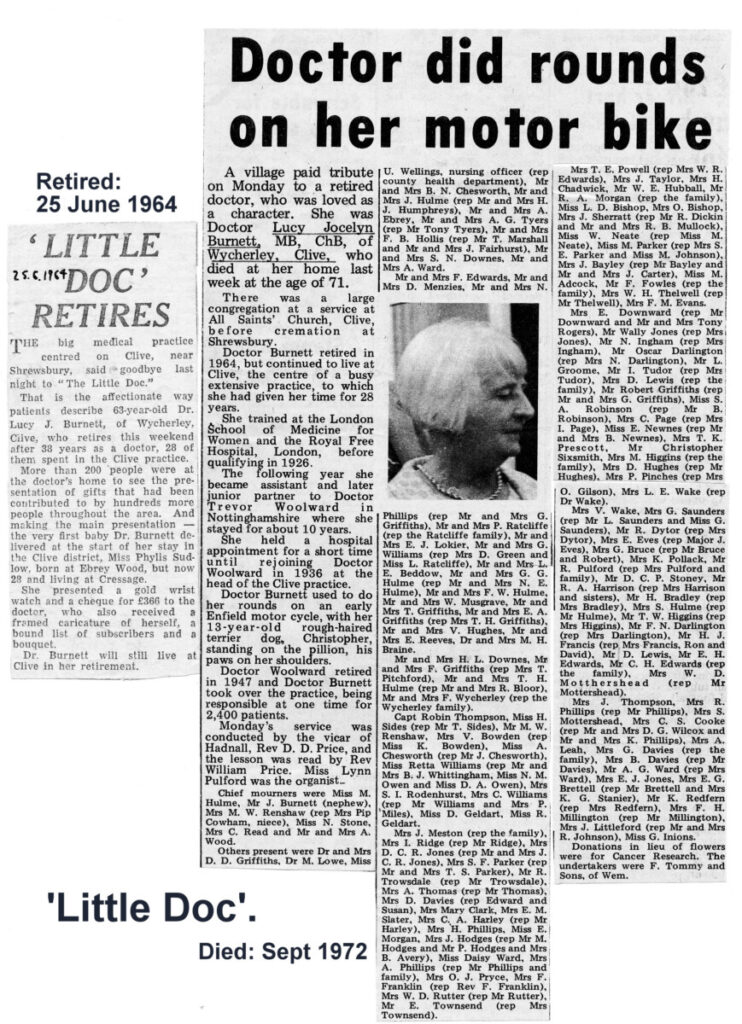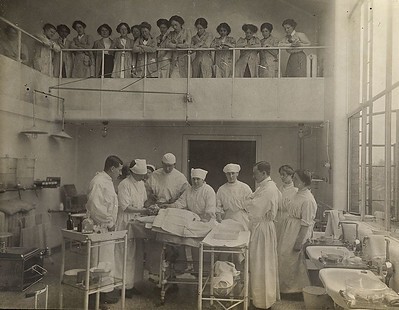Dr Lucy Jocelyn Burnett (General Doctor, Colston Bassett 1927-1935):
Blog Post (March 2023):
Welcome to the wonderful story of Dr Lucy Jocelyn Burnett – she was Hickling’s first lady doctor and she practised in our area from 1927 to 1935. Maggy Wadkin wrote that her arrival, ‘put the cat amongst the pigeons’ but that everyone quickly became very fond of her.
She was ‘a little slip of a thing’ but she did her rounds on an early Enfield motor-cycle or in her sports car and she was always accompanied by her dog, Christopher – he rode pillion on the back of the motorbike, wound up the local dogs with his barking and sat outside each home as the ‘Little Doc’ made her visits.
As a young woman of 26 when she came to the area she was a pioneer amongst women emerging in the medical profession and she undertook all the roles that you would expect; including weekly drop-in clinics at the Chapel, midnight dashes on horseback through the floods to attend a Hickling birth and the work we now associate with paramedics – first on the scene at accidents and tragedies across the Vale of Belvoir (the news clippings of these incidents paint a vivid picture of her life).
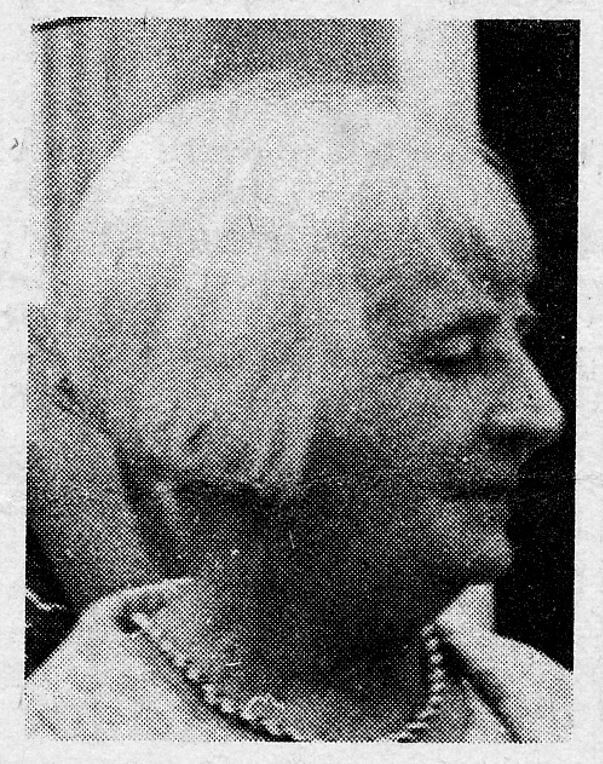
There are lots of anecdotes, news clippings and memories of her at her retirement and the time of her death, below – we hope you will come to love her as much as we do!!
In 1935 she moved to Clive in Shropshire where she remained until her death in the 1970s; we are very grateful to the local history group in Clive and Grinshill who have filled out her story and given us the only photographs we have of her. We hope that more will follow!
Whilst researching the family attached to the Hickling village business, Burnetts, an un-related name emerged; Dr Burnett, a female doctor. Working from Colston Bassett she was a general medical practitioner whose work took her to villages across the Vale of Belvoir and, after the initial surprise, was viewed very fondly!
- Grantham Journal August 3rd 1935. “Presentation. An interesting event took place at The Rectory on Tuesday when Mrs Foster and Miss Pinchbeck who had canvassed the village and the pastures for subscriptions, presented to Dr Burnett, the lady assistant to Dr Woolward, who is leaving the district, a cheque in appreciation of her services. Dr Burnett is highly respected and her departure is regretted.”
- (Maggie’s Memories p.59) After Dr. Windley retired at Colston Bassett, Dr. Woolward took the practise, he was a younger man and a favourite with everybody, he was tall and very good looking, he took as Partner Dr. Burnett a lady, well that put the cat among the pigeons, it was the first time anyone local had anything to do with a Lady Doctor, but after a while she became a welcome visitor, she was a tiny slip of a thing she rode a motor cycle and her little dog rode on a special carrier always barking its head off. Dr. Burnett also had a fast sports car, I remember Slater Shelton fetching her when his eldest son was born, there had been a heavy storm and the roads were flooded, so Slater went along to Colston Bassett on his horse called Daisy and Dr. Burnett joined him on Daisy’s back to come back to Hickling through the floods and deliver young John Shelton. When Dr. Woolward and his family left Colston Bassett, Dr. Burnett went along with them and Dr. Roche came, he was older, a good Doctor, and he stayed until his retirement.
- (Maggie’s Memories p.39) The Welfare Clinic has been held in the Sunday school since it first started (and still is) and that is forty one year’s this year of 1976, and why I know, it was the year when Keith was born and he was only a few weeks old when the opening clinic took place, and I always say the Clinic, Cow & Gate Food, and Dr. Burnett (lady Dr. from Colston B.) saved his life, he was a poor little mite.
Lucy Jocelyn Burnett sounds like an extraordinary woman – she trained as a doctor at a time when this would have been very unusual; unusually, she worked in a rural practice; she (and her dog) rode a motorbike and drove a sports car; newspaper reports describe her place firmly at the ‘business end’ of the work. Anecdotes and news reports, despite the initial surprise, also show that she was much-loved and well respected.
Lucy Jocelyn Burnett was born in 1901 in Southampton; her father was a stockbroker and the family seem to have been prosperous. Her elder sister, Ellinor Marjorie Burnett also trained in medicine and became a house surgeon at the Royal Surrey Hospital.
In 1921 Lucy Burnett is a medical student at the University of London and, by 1927, she is settled in a rural practice in the household of Dr Arthur Woolward in Colston Bassett – she is only 26 at this time. Their practice is based at The Yews, Colston Bassett – a property long associated with successive doctors in the village and their surgery would have been at the house. From here they ran clinics, were called out to patients around all the neighbouring villages in the Vale of Belvoir and, according to newspaper reports, they did the work we now associate with paramedics, too (frequently being first on the scene of accidents and tragedies; in 1932 she is called to a child scalded by boiling water and immediately drives her straight to the children’s hospital in Nottingham).
Dr Lucy Burnett had a very distinctive style of her own; she did her rounds on a motorbike or in her sports car. Either way, she was always accompanied by her terrier, Christopher – best known for his barking and for winding up the village dogs as they passed. When Dr Burnett made her house calls, he would sit outside waiting for her to return. Christopher would ride pillion or in a basket on the motorbike and sometimes, it is reported, on the bonnet of the car – the sound of his barking was a sure sign that the doctor was on her way. She worked closely with the village communities that she served; running clinics and serving as President of the Cropwell Bishop WI. Accounts of her riding with a farmer on horseback through floods to deliver his child in the middle of the night, give a sense of her character and resolve.
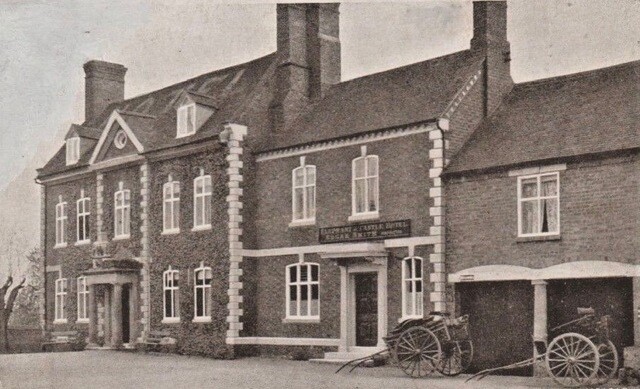
Although she only lived and worked in the area for 8 years she made her mark; remarkably, she was only 26 when she first came to Colston Bassett and just 34 when she moved on. A hint of the difficulties she may have faced as a woman in this role can be found in newspaper cuttings which often refer to her as ‘he’ – an unconscious expectation that any doctor must be male …
In 1935, she and Dr Woolward moved to Clive in Shropshire (where his wife’s family lived) and she remained practising medicine in the area for the rest of her career. Much of this time, she lived in the Elephant and Castle Hotel in Clive – she never married. Dr Burnett died in 1972.
- https://www.closedpubs.co.uk/shropshire/grinshill_elephantcastle.html
- https://clivegrinshillhistory.wordpress.com/
Sadly, we have very few photographs of Dr Burnett – if you can help, please contact us!
Contents:
- Anecdotes and newspaper cuttings
- Dr Lucy Jocelyn Burnett – public records
- Dr Arthur T Woolward – public records
- The Shropshire Years
- Women in Medicine, a context.
Anecdotes & Newspaper clippings (the Colston years):
In addition to the articles transcribed (below) there are several more available in newspaper archives describing Dr Burnett’s activities as President of the Cropwell Bishop WI and others referencing her work as a doctor. Interestingly, most of these refer to Dr Burnett as a male doctor* but, as they also place Dr Burnett in Colston Bassett, it seems most likely that this is down to lazy editing with a nod to how unusual it was, at this time, for a general doctor in a rural practice to be female.
Market Harborough Advertiser 4th January 1929: Died A-Hunting As He Wished – Mr WM Wroughton Killed at High Fence – Various Local Associations. The tragic hunting accident on Saturday that caused the death of Mr William Musgrave Wroughton brings to light his own oft-repeated remark that he wished, when his time came, to die in the hunting field. There were, indeed, few better known hunting men in Northamptonshire than Mr Wroughton who at different periods held the mastership of the Woodland Pytchley and the Pytcheley packs and during his association with the Brigstock kennels became closely associated with the Kettering and District General hospital (as a Governor) and other local charitable organisations and institutions. How Fatality Occurred. Mr Wroughton who was 78 years of age met his end while out with the Belvoir Hounds at Colston Bassett, Nottinghamshire, the field also including the Prince of Wales who was leading the field at the time and so was not a witness of the painful occurrence. It appears that he was seen to ride at a high fence in a field between the Harby and Langar roads but instead of rising, his horse brushed through it, stumbled on the other side and fell. Mr Wroughton was thrown violently on to his head, and while he lay on the ground his horse rolled over him and kicked him on the head. Brig.General Sir Edward Le Marchant, Air-Commodore Longmore, and Capt. Bingham Turner, who had just previously jumped the same fence, and in which there was no wire, heard the crash, and hastened to Mr Wroughton’s assistance, but he expired soon after their arrival. While an ambulance was being summoned from Melton Mowbray, Sir Edward placed his pink coat under Mr Wroughton and galloped to his residence, Colston Bassett Hall, for blankets. Dr Burnett and Dr Woolward speedily appeared on the scene. The body was taken from the field on an improvised stretcher, placed in the ambulance and removed to the Martin’s Arms, Colston Bassett. The circumstances were reported by the police to the District Coroner (Colonel H Bradwell). The inquest will not be held until Friday. The Coroner, however, has granted a burial order, so that the funeral may be facilitated. Mrs Wroughton, who was at Creaton Lodge received the news of the tragedy in a telegram sent by Mr Wroughton’s groom. No other member of the family was with her at the time, her two daughters being abroad. Mrs Wroughton bore up most courageously under the blow, and there ensued at Creaton Lodge a period of over an hour’s painful waiting for details of the tragedy. The Prince who was unaware of what had happened, was greatly distressed when he heard the tragic news. Members of the hunt generally were not aware of the tragedy, and it was not until the gallop had ended that the news reached them. Hounds were at once ordered back to the kennels. (… obituary …)
Nottingham Journal 13th July 1929: Throat Wound. Cropwell Bishop Man’s Serious Condition. Mr John Cumberland (84) described as retired of Cropwell Bishop was admitted to the Nottingham General Hospital last evening suffering from a wound in his throat. Mr Cumberland, who is well known at Cropwell Bishop, living alone it is said, but was in the habit of visiting friends at Nottingham. Shortly after his return from Nottingham yesterday he was found with his throat cut in his house. Dr Burnett and Dr Woolward were called in and they ordered Mr Cumberland’s removal to the General Hospital. His condition is serious.
Nottingham Evening Post 23rd August 1929: Two steam cultivators owned by Mr Edward Morley of Harlaxton-road, Grantham, were proceeding from Leicester to Newark on the Fosse Road yesterday, when at a spot near the Cotgrave cross-roads, one of them suddenly got out of control as it was descending a hill. It ran through a hedge, plunged down a 12ft escarpment, and overturned, dragging with it a living van and water cart. The engine weighed about 12 tons. The driver, William Chapman, of 104 Norton-street, Grantham, and the steersman, William Islip, of Hough-on-the-Hill, near Grantham, had miraculous escapes from death, the fact that they were inside the driving cabin saving them from being crushed under the heavy machine and the two waggons. They escaped with several bruises and minor cuts, and were speedily taken by passing motorists to the Newark Hospital. James Lear, aged 47, of no fixed abode, a cook, who was travelling in the living van, was not so fortunate. He sustained injuries to his right hip and ribs. He, too, was removed to Newark Hospital after receiving attention, with the othe two men, from dr Burnett, of Colston Bassett. The cause of the accident is a mystery, but it is said that the side of the road gave way. Our photograph shows the wrecked engine and van after the accident.
Nottingham Journal 23rd August 1929: Traction Engine Overturns – Amazing Escape of Occupants. Three Grantham men who were on a 12-ton traction engine which got out of control and eventually overturned – together with a van and a water cart – down a 10-foot embankment at Cotgrave last evening, must deem themselves fortunate in escaping death or serious injury. Two traction engines, belonging to Mr Edward Morley, of Grantham, were proceeding down the Fosse Way near Mr J Clarke’s farm at Cotgrave when the engine in the rear by some means got out of control and went careering at a mad pace down the gradient. Ram Into Embankment. Running into the embankment at the side of the road, the engine, together with the water cart and van it was drawing, toppled completely over falling a distance of over ten feet. How the driver, William Chapman, of 104, Norton-street, Grantham, his steersman, William Islip, of 8, Hough-on-the-Hill, Grantham; and the cook, James Lear (who was riding on the water cart) escaped serious injury must be conjectured. It is believed, however, that they actually fell over the embankment with the engine, and managed to escape from under the overturned vehicle after it had crashed. Men Taken to Hospital. It was at first thought that one of the men had been killed, and was still under the engine. The Nottingham City Ambulance was summoned, but the men were conveyed to Newark Hospital by a private car. They are suffering from slight injuries and shock and were first attended by Dr Burnett of Colston Bassett.
Grantham Journal 2nd November 1929: Harby WI – Dr Burnett adjudicated a competition, ‘The Twelve Best Things for a Household First-Aid Box’.
Grantham Journal 22nd February 1930: On Friday evening the Belvoir Branch of the British Legion held a fancy dress social at the Council School, the proceeds being in aid of the Legion House Building Fund. Mr E Faulks, Miss Smith, Mr Hawkins (Upper Broughton) and Mr CG Milnes (Nether Broughton) were the artistes, and contributed pleasing and appreciative items. In the fancy dress parade, the rprizes were awarded as follows: 1. Peter Marriott, paper lad; 2. Miss Evelyn Sims, Flanders poppy; 3. Mrs G Shelton, old-fashioned lady; 4. Mr Geo. Squires, sweep; Miss Evelyn Squires, Spanish lady; special, Mrs Aston, sweep. Dr Burnett (Colston Bassett) and Miss Atkinson (Long Clawson) judged the fancy dress. The Building Fund profited to the amount of £2.4s.9d. Mrs E Faulks and Miss M Shelton were the pianists.
Nottingham Evening Post 27th May 1930: Colston Bassett Tragedy. Wife of Farmer Drowned In Pond. Harriett Mary Wagstaffe, aged 69, wife of Charles Wagstaffe farmer of Manor Farm, Colston Bassett, died under tragic circumstances yesterday. About five o’clock her son Herbert was walking across the home field to the farm. When near a pond in the middle of the field he heard a gurgling noise and saw his mother in the middle of the pond. He called for help, entered the water, and got her to the side. The husband and Mr Thomas Barnett of Colston Bassett came along and while artificial respiration was being tried, Dr Burnett and Inspector Wilson were sent for. On *his arrival, the doctor pronounced life extinct.
Nottingham Journal 11th August 1930: Car Overturns on Roadside – Early Morning Crash Near Widmerpool – Seven Injured – Two-Month-Old Child Least Hurt. A serious motor accident occurred at Hickling Pastures near Widmerpool about 8 o’clock yesterday morning. Seven people – four adults and three children – were injured. Mounted Bank. Rut In The Road Apparent Cause Of Accident. The injured people were; William George Marshall (26) of 7, Cecil-road, Croydon, broken collarbone and injury to back ; Miss Ivy Ancombe (21) of the same address, concussion and injury to shoulder; Mr William Driscoll (30) 9, Park-terrace, St. John’s-road, Carshalton, abrasion about the head; Mrs Norah Driscoll (22) of the same address, abrasions and injury to left arm; Daniel Driscoll (2) slight abrasions about the head; Donald Driscoll (12 months) slight abrasions and shock; and a two-month-old baby, slight shock. It seems that Mr Marshall, accompanied by his fiancée, Miss Ancombe, set out with his car to take the Driscoll family from London to Sheffield shortly after 1am yesterday. Thrown into Road. They travelled via Kettering and Melton Mowbray and were passing Mr EJ Hollingworth’s farm at Hickling Pastures – about half-a-mile beyond the Widmerpool cross-roads – when the front wheel of the car apparently struck a rut by the side of the grass verge causing the vehicle to mount the bank. Apparently the steering wheel was wrenched out of the driver’s hands, for the car swung completely round facing the direction in which it had come and overturned, throwing all the occupants into the road. Resident Awakened. Mr Hollingworth heard the noise caused by the car turning over from his bedroom and hurriedly dressing he ran out to assist the injured people. With assistance he carried them into his house and then summoned Dr Burnett (a lady practitioner) from Colston Bassett and the Nottingham City Ambulance. Dr Burnett, who was quickly on the scene, rendered first aid and the party was conveyed to the Nottingham General Hospital where Mr Marshall and Miss Anscombe were detained. Remarkable Escapes. According to Mr Hollingworth, it was remarkable that none of the party was killed and equally extraordinary that the two-month-old baby was least affected. On leaving the hospital the Driscoll family, who were stranded as the result of Mr Marshall being detained, were taken to the Nottingham Guild Hall, where Mr Driscoll explained that he left London with the intention of going to Sheffield to stay with friends in the hope of securing employment in that city. In view of the fact that the accident occurred in the county, the County Police befriended the family and they were enabled to complete the journey to Sheffield by train. The condition of Mr Marshall, the Journal was informed last night, was very serious. There was no material sign of improvement either in the condition of Mr Marshall or Miss Ancombe at midnight.
Grantham Journal 15th November 1930: Accident. Early on Friday evening a motor-cycle accident occurred on the Granby to Barnstone-road about halfway between Granby and Barnstone Station. Mr Fred Shelton, of Whatton-in-the-Vale, was returning from his work and was overtaking some workmen on pedal cycles when he collided with a pony and cart, driven by and belonging to Mr R Branston of the Station Farm, Granby. Mr Branston and his pony escaped unhurt, but the cart was somewhat damaged. Mr Shelton’s right leg was very badly cut and bruised, but not broken and both his wrist and head received injuries. His motorcycle was completely smashed. Mr Shelton was conveyed to a friend’s house at Ivy Cottages, Barnstone Station, and Dr Burnett of Colston Bassett was very quickly in attendance. The injured man was taken to Nottingham General Hospital on Saturday by the kindness of Mr Plowright of Barnstone. He was not detained, and during the day he was taken to Whatton, and he is making steady progress towards recovery.
*West Bridgford Times & Echo 19th June 1931: Died Whilst Visiting Son (…) at Cotgrave. ‘Complaining of pains in the chest the old lady sat in a chair and died immediately. Dr Burnett of Colston Bassett was called and he found that Mrs Hayes was beyond human aid …’
Grantham Journal 16th January 1932: The Passing of Mrs Mary Allsop, widow of Mr George Allsopp at the age of 90, removes from our midst the oldest lady inhabitant. She came to reside in the village in 1920 with her relatives, Mr and Mrs S Egglestone, at Fern Bank. Until a few years ago she was erect, brisk and vivacious, but with advancing years her eye-sight and memory failed. She was fond of reading and delighted to talk of her early married life. A few days previous to Christmas she left the village with Mr and Mrs S Egglestone to spend a few days with relatives at Plumtree Park. It was plainly seen that she was unwell, and Dr Burnett of Colston Bassett was summoned to attend her. Her remains were interred in the Parish Churchyard, Rempton, on Thursday week.
Nottingham Journal 29th June 1932: The Prince of Wales flew to Nottingham (arriving at Tollerton aerodrome) for a 6-hour visit to celebrate volunteering which included visits to Cotgrave and Cropwell Bishop. “Never before has the Prince come into such close contact as will be possible to-day with the remarkable social rendered in humble ways in the city and the immediate rural area. Hitherto fete days have involved staid official functions and set ceremonies but today the Prince will make contact in homely and unconventional ways with the everyday activities of Nottingham and villages across the Trent … At 2pm, the Prince … will motor direct to Cropwell Bishop via University-boulevard, Castle-boulevard, Arkwright-street, Trent Bridge, Radcliffe-road as far as [Holme House] where he will turn off for Cropwell, where he is due to arrive at 2.20. During his 15 minutes stay the Royal visitor will see over the new village hall and garden, and will inspect the proposed playing field. At Cropwell Bishop the War Memorial scheme takes a double form – a window in the church in memory of the fallen and a common meeting place in the village for those who remain.” Amongst those listed ‘in attendance’ is Dr Burnett representing the WI.
Nottingham Journal 15th August 1932: Pond Tragedy. How a 16-year old boy, unable to swim, lost his life yesterday on going to bathe in a pond in a quarry comes from Barnstone, Notts. The lad, Frank Waring, who lived at Spring Cottage, Barnstone, went with Arthur Sharpe and Frederick William Baxter, who also reside in the village in a pond in a quarry at the Barnstone Cement Works about 10.30. Waring waded into the water to his waist when suddenly he fell backwards and disappeared. Sharpe at once dived into the water at the spot where the lad had been standing but failed to find him. His companion communicated with PC Pass and he with PC Clarke dragged the pond, recovering the body about two hours later. Dr Burnett of [Colston Bassett] was summoned but every effort to restore animation failed. The pond in the quarry is frequently used by bathers but the unfortunate boy fell into a deep hole.
Nottingham Evening Post 4th November 1932: Cropwell Bishop Baby’s Tragic End. Coroner on Unguarded Fire Danger. Another warning to parents on the necessity of providing proper fireguards to prevent children coming into contact with vessels of boiling water, was issued by the Nottingham City Coroner (Mr CL Rothera) at an inquest at the Nottingham Children’s Hospital today. He was inquiring into the death of Josephine May Sheppard, the 19-months-old child of Arthur Sheppard a gypsum mineworker of Cropwell Bishop. The child died in the hospital on Wednesday as a result of scalds, caused by the upsetting of a saucepan left on the trivet beside the fire. The mother, Harriet Sheppard, said she left the child with five others, the eldest 12, in the kitchen on Sunday morning while she went into the scullery. She had only been gone a minute when she heard the baby scream. Unsuitable Guards. She went back into the kitchen and found the baby lying in the hearth. A saucepan she left on the trivet was overturned, and the child was scalded. Mrs Sheppard said she sent for Dr Burnett who took the child at once to the Nottingham Children’s Hospital. Answering the coroner, the mother said she had a guard, but that was round the scullery fire, as that was the more dangerous one. It was a guard with iron bars. The Coroner: Those guards are not much good, anyhow, as a child can put its hand or a piece of wood through the bars. But in this case the guard was in the room. Dr Henrietta MacLeod said the child died from pneumonia consequent upon severe scalds on the left side.
Grantham Journal 17th Dec 1932: Cropwell Bishop WI – Dr Burnett appointed president.
Grantham Journal 13th May 1933: At the monthly WI meeting, president, Dr Burnett ‘gave a demonstration of Barbola work, which was much appreciated’. (Barbola work; decorative 3-D models of flowers used to decorate small objects such as mirrors and vases – it was bought as a thick paste ready-mixed in tins.)
Grantham Journal 29th April 1933: Cropwell Bishop; Dr Burnett attended to the injuries of Mr Robert Anderson who had an accident on his motorbike on his way to work when crossing the Fosse-Road, Stragglethorpe. He had severe injuries to the ankle, ribs, head and face and was conveyed to Nottingham Hospital where ‘he is progressing favourably’. ‘Mr Anderson has been one of the hardest workers for the Memorial Hall and always ready and willing to do any work voluntarily for the Men’s Institute, Hall and Playing-field. Much sympathy is felt for his wife and daughter.’
Grantham Journal 19th August 1933: Crash into railway bridge. On Tuesday, while cycling down the incline from Harby and Stathern station, Mrs Ivy Heywood, wife of Mr Harry Heywood, farmer, of Stathern Lodge, apparently lost control of her machine, and crashed into the brick all of the railway bridge. She was rendered unconscious, and was taken home, where she was attended by Dr Burnett of Colston Bassett. Mrs Heywood’s injuries were principally of a facial nature, and she is recovering from the effects of her fall.
Nottingham Evening Post 16th December 1933: Inquest unnecessary. Mr Walter Whitworth, 54, a farmer, of Tithby, died suddenly yesterday at his home. Following a report from Dr Burnett of Colston Bassett that death was due to heart failure brought on by acute gastritis, the Nottingham District Coroner (Lt. Col. H Bradwell) has issued a certificate, no inquest necessary. Mr Whitworth was a bachelor.
Grantham Journal 16th June 1934: Dr Burnett judged a baby show at the Nether Broughton fete, in aid of the Church Floor Fund.
Grantham Journal 4th August 1934: Dr Burnett gave a talk, ‘How to keep fit’ to Langar & Barnstone WI.
Nottingham Journal 27th August 1934: Five Dead in District Road Smashes – Head-on Crash into ‘Bus – Boy Cyclist Killed Near Cotgrave – Week-end Toll – Amazing Accident at Leicester. With many hundreds of East Midland folk awheel, tempted by the fine weather and sunshine, the week-end produced the usual crop of road mishaps, several of them of a fatal nature. Cotgrave Hill Crash. An enjoyable bicycle ride in which five Netherfield and Carlton boys indulged yesterday afternoon was attended by a shocking tragedy, one of the party being killed in a head-on collision with a motor-bus on Cotgrave Hill. He was Norman Thompson, aged 15, whose parents reside at 46 Victoria-road, Netherfield. It seems that the deceased and four companions set out on their bicycles for a run into the country, and when between Cotgrave and Cotgrave crossroad they met on a hill a motor ‘bus belonging to King’s Motor Service Company, Melton Mowbray, and driven by Mr Ernest Tidd of 18, Springfield-street, Melton Mowbray. Four of the young cyclists, who were travelling down-hill, succeeded in passing the ‘bus, but for some reason – there was no other traffic on the road – Norman Thompson got right into the track of the vehicle and collided with it practically head-on. He received severe head injuries, and when seen by Dr Burnett life was extinct. The body was taken to Cotgrave to await an inquest …
Grantham Journal 16th March 1935: Women’s Institute. Thirty seven members spent an enjoyable evening on Thursday week. Dr Burnett of Colston Bassett, gave an interesting and helpful lecture on ‘First Aid and what to do before the doctor comes’. Mrs T Starbuck’s group, Mrs Starbuck, Mrs H Marson, Mrs Herrick, Miss Whittle and Miss R Spencer were hostesses for the tea. Mrs Stuart Smith’s group, Mrs Foster and Miss Power, were in charge of the social half hour. Miss Mabel Salt was the winner of a competition with 210 articles put in a matchbox.
Grantham Journal 13th April 1935; Women’s Institute – at the monthly meeting held in the Memorial Hall on Tuesday there was a good attendance. The members of the Hickling WI had been invited and a fair number were present. The president, Dr Burnett, occupied the chair during the business part of the meeting and after the business had been transacted a demonstration of ‘home dyeing’ was given. Refreshments were served and a social evening was thoroughly enjoyed. Potatoes were distributed the produce to be given to Hospitals. It is hoped that not only members of the WI but other garden holders will follow this example.
Grantham Journal 15th June 1935; “Guide and friend of the village. When it became known to the people of Kinoulton that their medical attendant and friend Dr A Woolward owing to failing health was leaving the district after ten years of watchful care over their interests, a feeling of sorrow and regret was expressed. At a farewell gathering, Mr Joseph Keyworth, Mrs J Herrick, Miss Herrick, Mrs Cripps, Mrs A Flint, Mrs Hubbard and Messrs Geo. Oxby, Geo. Keyworth and Leslie spoke in appreciation of the doctor’s care and Mr WE Clifton presented a cheque for £& 12s.6d. subscribed from 69 homes in the village. Dr Woolward, in returning thanks, said how much he regretted leaving such kindly folk, and that he would never forget many a kindness shown to him. He introduced his successor Dr W Roche, who he hoped would merit the good wishes of the parish in the future. Miss Gladys Keyworth called for musical honours, and the meeting came to an end with memories of a man who was to all a guide, philosopher and friend.
Grantham Journal August 3rd 1935; “Presentation. An interesting event took place at The Rectory on Tuesday when Mrs Foster and Miss Pinchbeck who had canvassed the village and the pastures for subscriptions, presented to Dr Burnett, the lady assistant to Dr Woolward, who is leaving the district, a cheque in appreciation of her services. Dr Burnett is highly respected and her departure is regretted.”
Grantham Journal 3rd August 1935; “Kinoulton’s Lady Doctor – Presented with cheque from patients and friends. It was with much regret Kinoulton residents learned of the impending departure of Doctor Lucy J Burnett. On Friday an interesting little ceremony took place, when Mrs Albert Flint presented her with a cheque for £6.10s ‘from the patients and friends in Kinoulton – a token of appreciation and affection.’ Dr Burnett who was deeply touched expressed thanks to all for their kind gift, stating that with it she would buy something in connection with her work as a doctor. She would always remember her Kinoulton friends. Mrs Cripps spoke of the splendid work and kind helpfulness of Dr Burnett and assured her of their best wishes for the future. ‘In mentioning the departure of our good friend, Dr Burnett, we must also say good-bye to Christopher, her dog, a clever wire-haired terrier.’ Writes a correspondent. ‘We know him as an accomplished rider on the pillion seat of the doctor’s motor-cycle, on the motor-car hood, and as a solemn, appealing, hazel-eyed doggie waiting for his mistress outside our doors. Sometimes he was no angel, but a born Bohemian and did his roistering openly and defiantly, causing the the exasperated and furious barkings of every other dog for half-a-mile round. He heralded the doctor’s approach; he chased the cats; he made them swear; but he was ‘Christopher’ and we shall miss him.”
Grantham Journal 17th August 1935; “Cropwell Bishop. Losing their President. When the Women’s Institute met on Tuesday the president, Dr Burnett, who is leaving the district, made a few remarks on the subject of her retirement, and was then presented with a handsome brush and comb in a beautiful case, suitably inscribed. Mrs Parkin made the presentation on behalf of the members, and Dr Burnett very feelingly thanked them for their kindness and appreciation of her work. Not only the Women’s Institute, but the villagers in general express regret at losing her services. Mr Chas. Hone gave an interesting talk on “Bees” and exhibited bees at work, with specimens of honey. Mr Hone, who lives in the village, is a well-known expert in beekeeping. Refreshments were served, and a social half-hour brought the meeting to a close.
Grantham Journal 24th August 1935: “A Loved Doctor. A presentation was made to Dr Burnett who is leaving the district at a meeting on Tuesday, presided over by Mr Prichard Barrett. Tributes to the doctor were paid by the chairman, Mrs Roche, Dr Roche, and Mr S Pritchett, who spoke of the love and devotion she bestowed on her patients. The presentation of an inscribed silver cigarette box was made by Mrs D’Oyley Ransome, who also thanked Dr Burnett for her services. The recipient, in reply, said she felt keenly the fact of leaving so many friends. The inscription on the box was: ‘To Dr Burnett, from her patients of Langar, Barnstone, Granby and Plungar for her services, 1927-1935’”
Dr Lucy Jocelyn Burnett (General Doctor, Colston Bassett 1927-1935).
Public Records:
1901 Census: 56, Westwood Road, Southampton, Portswood, South Stoneham, Hampshire
- Frederick J Burnett – Head – Married – Male – 36 – 1865 – Incorporated accountant & stockbroker – Southampton, Hampshire
- Florence E Burnett – Wife – Married – Female – 35 – 1866 – Abingdon, Berkshire
- Frederick H Burnett – Son – Male – 9 – 1892 – Southampton, Hampshire
- Ellinor M Burnett – Daughter – Female – 8 – 1893 – Southampton, Hampshire
- Leigh M Burnett – Son – Male – 4 – 1897 – Southampton, Hampshire
- Freda M Burnett – Daughter – Female – 1 – 1900 – Southampton, Hampshire
- Anna Gubb – Mother-in-law – Widow – Female – 73 – 1828 – Retired schoolmistress – Tiverton, Devon
- Eleanor Grist – Servant – Single – Female – 20 – 1881 – Nurse domestic – Southampton, Hampshire
- Ruth Pearse – Servant – Single – Female – 18 – 1883 – Cook domestic – Kingham, Oxfordshire
- Annie T Beach – Servant – Single – Female – 23 – 1878 – Housemaid domestic – Fairoak, Hampshire
Birth record: South Stoneham, Hampshire – Q2 1901 – mother’s maiden name, Gubb.
1911 Census: Clarendon House 56 Westwood Road Southampton, Hampshire.
- Frederick John Burnett – Head – Married – Male – 46 – 1865 – Stockbroker and accountant – Hants County Borough If Southampton
- Florence Elizabeth Burnett – Wife – Married – Female – 46 – 1865 – Berks Abingdon – married for 22 years – 8 children born alive, 6 still living and 2 have died.
- Frederick Hugh Burnett – Son – Single – Male – 19 – 1892 – Accountancy student articled – Hants Southampton
- Ellinor Marjorie Burnett – Daughter – Single – Female – 18 – 1893 – Medical student – Hants Southampton (in the 1921 census she is listed as a house surgeon at the Royal Surrey County Hospital, Guildford. She is boarding with other staff).
- Freda Mary Burnett – Daughter – Female – 11 – 1900 – Taught of home – Hants Southampton
- Lucy Jocelyn Burnett – Daughter – Female – 9 – 1902 – Hants Southampton
- Cecily Elisabeth Burnett – Daughter – Female – 5 – 1906 – Hants Southampton
- Christiana Victoria Parris – Servant – Single – Female – 20 – 1891 – Cook domestic – Hants Southampton
- Alice Elizabeth Phillimore – Servant – Single – Female – 20 – 1891 – House parlour maid domestic – Hants Southampton
1921 Census: College Hall, Bying Place, St Pancras, London
(name mis-transcribed as Lucy Joycelyn Bernett) She is living in College Halls attached to the University of London – fellow boarders are all female and they include several other medical students.
- Lucy Jocelyn Burnett – female – born 1901 – census date 19th June 1921 – age 20yrs 0m – single – whole-time medical student – born Southampton, Hampshire.
- The form is completed by the female Principal & head of household, [Thyra Blanche Alleyne] (age 46, single – mis-transcribed as Taylor B Blague) who has entered the students’ surnames – the rest of the information is written in the students’ own hands.
- Also listed is the bursar, Lucie Ida Dobson (age 39, single).
- The household includes: 7 medical students; 4 art students; 3 ‘student’, 1 science student.
No trace of Lucy Burnett’s family has been found in the 1921 census (research ongoing).
Medical Studies: the 1921 census records Lucy Burnett as a medical student at the University of London; her obituary in the BMJ clarifies this with the information that she studied at the London School of Medicine for Women.
- see section, below – women in medicine
1927 Medical Register: interestingly, Lucy Burnett wasn’t recorded in Colston Bassett until the 1931/1932 edition of the Medical Register; however, listings were dependent on doctors notifying the GMC of a change of address and it isn’t uncommon for them to be out of date. Her entry in 1927 uses her home address and her sister, Ellinor is listed on the same page:
1927-1935: Dr Lucy Burnett is working as a general medical practitioner based in Colston Bassett and working with Dr Arthur Woolward. It isn’t known how they came together but they appear to have arrived at the same time. They both leave in 1935 and they both go to Clive in Shropshire (both listed here in the 1939 Register) – Dr Woolward’s wife, Hilda, grew up in this area and he practised in the area in the early 1920s. Although Dr Burnett stayed here until her death in 1972, the Woolwards later moved to Devon where he died in 1955 – more research is needed, but this change may coincide with the London Gazette entry (below) in 1952.
1929 electoral roll: The Yews,Colston Bassett. Listed at the same address are Arthur Trevor Woolward and Hilda Winifred Woolward.
- However, local knowledge indicates that she may have lived at Yew Cottage opposite the Yews rather than with Dr Woolward’s family at The Yews.
(possible) Passenger record, 28th September 1937: Lucy Burnett (age 36) of 8, Bassett Gardens, Southampton and Florence Forsdick (age 33) are listed as passengers from England to Genoa, Italy (departing Southampton) on the ship Marnix Van St Aldegonde.
1939: Elephant Castle Hotel, Clive, Shropshire, England
- Wallis J Taylor – 12 Apr 1886 – Male – Hotel Manager – Married
- Harriett A Taylor – 26 Dec 1884 – Female – Unpaid Domestic Duties – Married
- Lucy J Burnett – 01 Jun 1901 – Female – [mis-transcribed as ‘Marine’] Medical Practitioner Single
- Dorothy M Matthews (Jones) – 06 Jul 1903 – Female – House Work General – Single
- Vera H Davies (Booth) – 20 Nov 1923 – Female – Housemaid – Single
London Gazette 23rd May 1952: The Partnership between Robert Harold Spurrier of ‘Dunsmore’ Grinshill in the county of Salop, MRCS, LRCP, and Lucy Jocelyn Burnett of The Elephant and Castle Hotel, Grinshill, aforesaid, MB, BS is dissolved as and from the 31st March 1952 and each will continue in practice independently. Lucy J Burnett. Jacobs and Greenwood, 70, Old Broad Street, London, EC2 Solicitors for and on behalf of Dr RH Spurrier.
Retirement: 25th June 1964. “’Little Doc’ Retires. The big medical practice centred on Clive , near Shrewsbury, said goodbye last night to “The Little Doc” That is the affectionate way patients describe 63-yrear old Dr Lucy J Burnett, of Wycherley, Clive, who retires this weekend after 38 years as a doctor, 28 of them spent in the Clive practice. More than 200 people were at the doctor’s home to see the presentation of gifts that had been contributed to by hundreds more people throughout the area. And making the main presentation – the very first baby Dr Burnett delivered at the start of her stay in the Clive district, Miss Phylis Sudlow, born at Ebrey Wood, but now 28 and living at Cressage. She presented a gold wristwatch and a cheque for £366 to the doctor who also received a framed caricature of herself, a bound list of subscribers and a bouquet. Dr Burnett will still live at Clive in her retirement.
Report of Dr Lucy Burnett’s retirement in the Wellington Journal and the Shropshire News – 26th June 1964:
Patients, young and old, said their goodbyes on Wednesday to their doctor for the past 28 years, Dr Lucy Jocelyn Burnett, Wycherley, Clive. But they took their leave only of their medical practitioner. The “character” they have come to love, the friend and counsellor remain. Sixty-three-years-old Dr Burnett retires from practise this week-end, but she will continue to live at Clive, the centre of a busy, extensive practice to which she has given unselfishly her whole time and energies. She hands over to her partner, Dr. D.D. Griffiths who will continue the practice with Dr. M. Lowe. For Dr Burnett it will be respite from 38 years in medicine. She trained at the London School of Medicine for Women and the Royal Free Hospital London, before qualifying in 1926. The following year she became assistant and later junior partner to Dr Trevor Woolward at Colston Bassett, near Nottingham and was with him for about 10 years.
Happy association.
She held a hospital appointment for a short time before beginning her happy association with her present practice when, in 1936 she rejoined Dr Woolward, then at the head of it. Dr Burnett admits that she became accepted by her patients in those earlier days not without considerable help from her rough-haired terrier, Christopher. She used to ride an early Enfield motor-cycle on her rounds: Christopher used to stand on the pillion, his forepaws balancing on his mistress’s shoulders! For some four years until Christopher died at the age of 13, it used to provide Dr Burnett with a fine opening gambit on walking into the sick room.
Took over practice.
Dr Woolward retired in 1947 and eventually Dr Burnett took over the practice from ‘Wycherley’, her home. It now consists of some 2,500 [correction: 1,800] patients in a scattered area covering a 7-mile radius and including Wem, Myddle, Burlton, Cockshutt. Marton, Merrington, Bomere Heath, Harmer Hill, Shawbury, Broad Oak, even Harlescott in Shrewsbury, Edstaston, Newtown and Noneley. At one time, Dr Burnett was treating a list of 2,400 patients. Says Dr. Burnett: “The heart-warming thing is you are still looked upon as a friend, not just a disposer of certificates. You are still a friend to them, not just a machine. The introduction of the antibiotics is probably the greatest boon to the doctor in a general country practice, but people’s changing attitude to medicine is something in itself. Ten or fifteen years ago, a tablet wouldn’t do, it had to be a bottle of medicine.” Recalls Dr Burnett. “Now people will accept tablets and capsules and very occasionally will be content if you don’t give them either.” Her practice has taken up most of her time, but Dr Burnett once played for the Myddle hockey team.
Presentations. [missing section].
… [her patients] showed the esteem in which they held her by contributing more than £420 to her presentation fund. Said Mr F. Wycherley, chairman of the fund’s organising committee on Wednesday: “The response has been truly magnificent. It was not a question of an appeal, everyone was so anxious to give.” Mr Wycherley was speaking to some 250 people on the lawn of ‘Wycherley’, Dr Burnett’s home, where the presentation was made. The occasion meant a unique meeting. On behalf of subscribers, Miss Phyllis Sudlow presented Dr Burnett with a gold wristlet watch and a cheque for £366. She was born at Ebrey Wood in the Shawbury area of the practice, the first baby delivered by Dr Burnett. She is now 28 and living at Cressage. Dr. Burnett was also handed a list of subscribers, put into a bound book form by Miss Dorothy Geldart assisted by Miss C.M.Read, and presented with a caricature of herself by the artist, Mrs E.Campbell.
Bouquet presented.
Little Sarah Griffiths presented the doctor with a bouquet on behalf of Mr and Mrs K.R.Redfern who were unable to attend. Said Mr Wycherley in his warm tribute: “She has given her life to her patients and this is reflected in the very high regard in which she is held in the medical profession in Shrewsbury and elsewhere in the county. ”However, Dr Burnett would not be in full retirement. She would be acting as locum at times and remain living at ‘Wycherley’, so that she would still be a familiar figure in the district accompanied by her dog, Tulie. In her reply, Dr Burnett said that in her practice her life had been given a richness she could not express. As she spoke, at her feet lay yet another of the gifts to her – a rug made by another patient and craftswoman, Mrs T.Marshall. The presentation committee included representatives from all areas of Dr Burnett’s practice and sub-committees were formed in some of the larger areas. Mr F.B.Hollis was treasurer and his wife secretary. Refreshments were organised and served by a ladies committee.
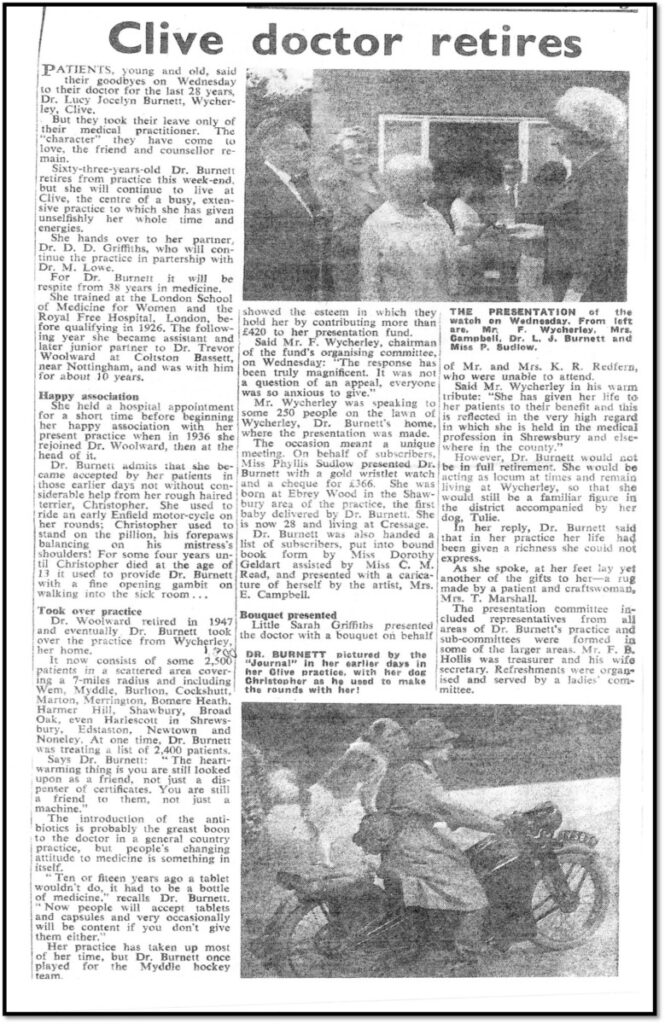
Death Record: Lucy Jocelyn Burnett – 1st June 1901 – died Q3 1972 – North Shropshire
- Burnett Lucy Jocelyn of Wycherley Clive Salop died 7th September 1972 Probate Sheffield 13th October £31,687.
- London Gazette 1972 (issue no.45786) – notice for claims: Burnett Lucy Jocelyn – Wycherley, Clive, Shrewsbury, Shropshire, Retired Medical Practitioner. 7th September 1972 – (persons to whom notices of claims should be given) Michael William Renshaw and Cerys Hughes both of 2 Belmont, Shrewsbury – by 1st December 1972.
- British Medical Journal dated 30 September 1972. LUCY J. BURNETT M.B., B.S. Dr. Lucy J. Burnett, who retired from general practice eight years ago, died at her home at Clive, Shropshire, on 7 September. She was 71. Lucy Jocelyn Burnett was born in Hamp[1]shire on 1 June 1901 and received her medical training at the London School of Medicine for Women, where she graduated in 1926. After holding hospital posts at Woking she joined a rural practice in Nottinghamshire and then in 1936 moved to the area of Clive, where she remained until her death. A tiny, eccentrically dressed figure, her life was utterly committed to her practice, and the “little Doc.,” puffing the inevitable cigarette and her black bag replaced by a school satchel slung over her shoulder, was a familiar sight in that part of Shropshire. She was accompanied on her rounds by her dog, latterly riding in the comfort of a car, but previously perched on the pillion of her motor-cycle. She was kind, and desperately tried to find some good in even the most difficult of patients, but if none could be found she would say so without hesitation. It is sad that shortly after her retirement she underwent a major operation and for the last six years of her life was far from fit and unable to enjoy fully the gardening she loved so much. However, her courage was remarkable, and the relentless deterioration in her health was received with a smile and, “Ah, well! Could be worse.” She was unmarried.
Dr Arthur Trevor Woolward: Colston Bassett.
Dr Lucy Burnett worked with Dr Woolward in Colston Bassett and she is listed in the same household at The Yews, Colston Bassett in electoral roll records. There are hints in news reports that they came to Colston Bassett at the same time and also left at the same time.
Timeline:
- Birth record: Q1 1891, Luton Bedfordshire
- 1891 census: Vicarage, Ryde, Totternhoe, Luton, Bedfordshire
- Spencer A Woolward – Head – Married – Male – 31 – 1860 – Vicar of Totternhoe – Little Gaddesden, Herts
- Agnes E R Woolward – Wife – Married – Female – 27 – 1864 – Lee, Kent
- Alfred J S Woolward – Son – Male – 2 – 1889 – Paddington, Middlesex
- Arthur T Woolward – Son – Male – 0 – 1891 – Totternhoe, Bedfordshire
- Sarah Bird – Servant – Single – Female – 19 – 1872 – Housemaid domestic servant – Eaton Bray, Bedfordshire
- Mary E Morris – Servant – Single – Female – 25 – 1866 – Nurse domestic servant – Iffley, Oxfordshire
- Elsie Watson – Servant – Single – Female – 25 – 1866 – Cook – Lincs
- 1901 census: The Rectory, Church Street, Dunnington, York, Yorkshire
- Spencer A Woolward – Head – Married – Male – 41 – 1860 – Clergyman in the Church of England – Little Gaddesden, Herts
- Arthur T Woolward – Son – Male – 10 – 1891 – Totternhoe, Bedfordshire
- Maud G Medcalf – Governess – Single – Female – 22 – 1879 – Governess – York
- Mary E Mortimer – Servant – Single – Female – 27 – 1874 – Cook domestic – Dunnington, Yorks
- Margaret Clark – Servant – Single – Female – 18 – 1883 – Housemaid domestic – Dunnington, Yorks
- Alice Oxtoby – Servant – Single – Female – 15 – 1886 – Kitchen maid domestic – Dunnington, Yorks
- Census 1911: 43 Wheeleys Road Edgbaston, Edgbaston, Warks
- Sarah Matilda Showell Rogers – Head – Widow – Female – 51 – 1860 – Private means – Leicester
- Ethel Marion Showell Rogers – Daughter – Single – Female – 22 – 1889 – Edgbaston Warks
- Eric Norman Showell Rogers – Son – Single – Male – 20 – 1891 – Cambridge medical student – Warks Edgbaston
- Arthur Trevor Woolward – Visitor – Single – Male – 20 – 1891 – Cambridge medical student – Beds Tottenhoe
- Sarah Summer – Companion – Single – Female – 45 – 1866 – Lady’s companion – Warks Langley
- Beatrice May Davis – Servant – Single – Female – 27 – 1884 – Housemaid domestic – Worcs, Selly Park
- Marriage: Arthur T Woolward to Hilda W Hunt Q2 1915, Ellesmere, Shropshire.
- Census 1911: The Fire Baschurch Shropshire, Baschurch, Shropshire
- Isabel Georgina Hunt – Head – Widow – Female – 48 – 1863 – No occupation – Warwickshire Parish of Barford
- Muriel Penelope Hunt – Daughter – Single – Female – 20 – 1891 – Of private means – Tasmania County of Devon
- Hilda Winifred Hunt – Daughter – Single – Female – 18 – 1893 – Of private means – born Tasmania County of Devon
- Mary Elizabeth Roberts – Servant – Single – Female – 28 – 1883 – Cook- general domestic – Henbarns Shropshire
- Census 1911: The Fire Baschurch Shropshire, Baschurch, Shropshire
- War records: Arthur Trevor Woolward – 1914-19 – Captain – Royal Army Medical Corps. London Gazette in 1914 records his temporary appointment as Second Lieutenant on 5th October. London Gazette 20th Feb 1917 – Special Reserve of Officers, supplementary to regular units or corps. Royal Army Medical Corps – the undermentioned to be Lts: Arthur Trevor Woolward.
- Census 1921: 53, Salop Road, Oswestry, Shropshire – Hilda has married Arthur Woolward by this time but he is in London on medical practice at the time of the census (although he is listed as employed at the Orthopaedic Hospital in Oswestry, Shropshire). She is recorded under her maiden name but their children are recorded as ‘Woodward’.
- Isabel Georgina Hunt – Head – Female – 1862 – 58 – Barford, Warwickshire, England Home Duties
- Muriel Penelope Hunt – Daughter – Female – 1891 – 30 – Home Duties
- Hilda Winifred Hunt – Daughter – Female – 1892 – 28 – Home Duties
- Margaret Phyllis Woodward – Granddaughter – Female – 1917 – 4 – Baschurch, Shropshire
- Evelyn Joan Woodward – Granddaughter – Female – 1920 – 1 – Myddle, Shropshire
- Eveline Russell Cunningham – Visitor – Female – 1890 – 31 – Tongue, Sutherland, Scotland – Home Duties
- Census 1921: City of London, Maternity Hospital, City Road, Finsbury, London
- Arthur Trevor Woolward – student – age 30yrs 6m – male – married – born Tottenhoe, Beds – medical practitioner – medical practice Shropshire Orthopaedic Hospital – Oswestry – he has 2 children, age 4yrs and age ‘under one’.
- He is in boarding accommodation with a Matron as head of household and other students.
- Electoral registers: 1928 – 1930 (for example) – Colston Bassett (1928), The Yews, Colston Bassett (1929 & 1930).
- 1939 Register: Dunsmore, Clive, Shropshire
- Arthur T Woolward – 13 Feb 1891 – Male – Medical Practitioner – Married
- Hilda W Woolward – 05 Sep 1892 – Female – Unpaid Domestic Duties – Married
- Margaret R Woolward – 09 Sep [1916] – Female – Masseuse – Single
- Evelyn J Woolward – 22 Jan 1920 – Female – Student – Single
- Annie J Stone 17 Aug 1900 – Female – Secretary – Single
- Edith G Ollier (Thomas) – 16 Feb 1919 – Female – Domestic Servant – Single
- Death record: Newton Abbott, Devon – Arthur T Woolward (born 1891) died Q2 1955
- Probate: Woolward Arthur Trevor of Teign Lawn Bishopsteinton Devonshire died 4th April 1955 Probate Liverpool 22 July to Hilda Winifred Woolward widow. Effects £19061.4s.3d.
The Shropshire Years
With grateful thanks to the Clive & Grinshill history group – click here
Some notes from Grinshill & Clive:
- (B Bishop): “I myself have clear personal memories of Dr Burnett, not least as her ‘Wycherley’ residence at Clive was sited directly opposite our family home on Back Lane. As an inveterate climber of trees in my younger years, my scalp still bears witness to her needlework skills following a series of dramatic falls. My father always maintained that she had finally resolved to live opposite us in order to save on her journey time given to the number of calls upon her expertise. Although at first sight a diminutive figure, to a young patient she always made a strong impression – whether by her habit of administering an injection through any inconvenient clothing before you could react; or by the ever-present cigarette which threatened to worsen your condition during any close examination or the dreaded thought that she was contemplating the cauterization of the wound. Her arrival by motorcycle or sports car, always accompanied by her faithful dog, succeeded in adding a certain drama to even the most routine of calls.”
- Initially the ‘Clive’ Practice covered both villages of Grinshill and Clive with the surgery of Dr Woolford and Burnett held at Dunsmore in Grinshill [next door to Stone Grange]. Interestingly Grove Cottage [later named Camelot] became the residence of her brother: Leigh Mathieson Burnett (3rd Oct 1896 – 30th Mar 1969] and his second wife Enid Olive Burnett 924th Oct – 9th Aug 1965) and both are interred at Grinshill churchyard. Entering Leigh Mathieson’s name into the 1901 Census does reveal many of the extended family with Lucy just missing the Census date. Until her move into ‘Wycherley’, she lodged at the Elephant & Castle in Grinshill as the 1939 Register correctly records.
- Following the departure of Dr Woolward to Devon, a Dr Robert Harold Spurrier (1900 – 1976) joined the Practice, although the partnership only lasted until 1952 as the London Gazette reveals when Little Doc moved to Clive.
- GRINSHILL; Dunsmore: This house was built in 1919 for the local doctor, Dr Irwin Brown Richardson, who established his medical practice here throughout the 1920s. By 1937 a Dr Arthur Trevor Woolward took over in partnership with Dr Lucy Jocelyn Burnett who later moved to set up her own Clive practice at Wycherley in Back Lane. Dr Robert Harold Spurrier [1900-76] is recorded as the village doctor for 30 years from 1946 until his death aged 76 years. His mother Florence [1876 – 1949] is also buried in Grinshill churchyard. The surgery was always located in the single storey extension where patients were able to simply turn up with no appointment required, and wait to see either doctor.
- CLIVE: Dr Burnett, known as ‘Little Doc’, bought the large plot of land where ‘Wycherley’ stands from John Fowles, and had the house built as her surgery and residence. Her pet dog became a familiar sight on the medical rounds: first when perched precariously on the doctor’s scooter, and later when running after her car through the village. Meadowfield Drive alongside was developed in the 1960s to contain ‘Heather Dell’.
- ‘Sherwood Memories’ – Susan Knight. At this point I must mention three women who, in their ways, made the community possible for families and particularly women who struggled to raise their families against almost overwhelming odds. Two were midwives: Nurse Duffy and Nurse Le Cornu. In those days, all women had home births. I am sure that Mum had a lovely personal experience – something I did not have in hospital. The new baby would then be there in its cot in our bedroom when we woke up. The midwives would pop in for a chat for weeks afterwards, something Mum really appreciated. Le Cornu is a Channel Island name and quite recently we used to give a lift to Bridge Club to a 90 year old, very quiet little woman called Avis Sowells who was also from Guernsey. She knew the Le Cornu family, but her own back story was particularly interesting because the Germans took over her home for their headquarters. The other amazing woman was the local G.P. – Dr Burnett. Unmarried, tweedy with grey, close-cropped hair, nothing was too much trouble for her. Legend has it that one winter, in thick snow, she borrowed a tractor to visit a patient in the cottage across the fields where the Kirkhams lived. I had a serious bout of glandular fever when I was fifteen. My throat was so swollen that she initially thought it was diphtheria. This frightened me almost to death because at the time posters were plastered everywhere with “Diptheria is deadly! Protect your child with immunisation.” I think they even featured a tombstone. She went to enormous trouble to get a blood test and popped in most days with books for me and to chat. I was just about to start my ‘O’ Level years. I suppose she found the contrast between Sherwood Bank and The Priory School intriguing.
- “Regarding the local names, Shropshire pronunciation is a potential quagmire and deeply divisive between the old stagers and the more recent arrivals. I was always taught to say Shrowsbury and Grins Hill, whereas Clive was always referred to as The Clive [linked to the Cliff nearby] but more importantly had to be pronounced as if rhyming with ‘Give’.”
(more to follow!)
Women in Medicine; some context.
Almost the first comment that is made when we begin telling the story of Dr Lucy Burnett is about how unusual it must have been for a young woman to be working in medicine at this time – particularly as a general/community-based doctor rather than working in a hospital environment. There is no doubt that it was unusual; however, the end of WWI brought many changes in society and women working in male-dominated professions was one of these gradually emerging situations – not least because a generation of young men had been decimated by the scale of wartime casualties and a generation of young women found their marital prospects severely reduced.
This is not to say that women were readily accepted by everyone in the medical profession or by their patients: Maggie Wadkin describes Dr Burnett’s arrival in this area most succinctly – “… he took as Partner Dr. Burnett, a lady, well that put the cat among the pigeons, it was the first time anyone local had anything to do with a Lady Doctor.”
An enquiry made to the General Medical Council (GMC) returned the following information and statistics:
“The first time that the GMC published a male or female designation was in 1974, before this we didn’t really keep a count of the number of women joining or on the register. However, we do have some data for selective years. I think it may have been provided by the Medical Women’s Federation who used to keep a count. They were founded in 1917 and its possible they have some information about Lucy (enquiries, ongoing). As you can see, being a woman on the register was comparatively rare.
- Year Men on the Register Women on the Register
- 1901 36,546 456
- 1911 39,383 930
- 1921 43,308 2,100
- 1931 50,304 5,300
- 1932 55,952 5,391
- 1941 60,692 6,300
- 1951 72,756 9,500
- 1961 85,248 12,800
- 1971 107,608 16,000
“I can also say that in 1926, the year she joined, the total number of people who joined the register was 2120 (1059 in England).”
- Medical Women’s Federation – a history: click here
- Historic England: London School of Medicine for Women – click here
- London Metropolitan Archives: London School of Medicine for Women – click here
- Royal free Archive Centre: undated early photographs – click here
- Science Museum: The Incredible Life Of Elizabeth Garrett Anderson (founder of the LSMW) – click here
- UCL London School of Medicine for Women – click here

